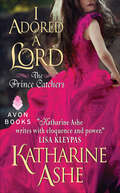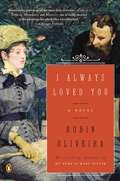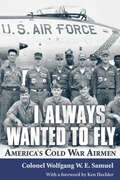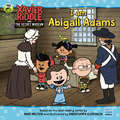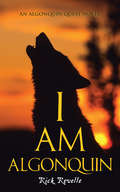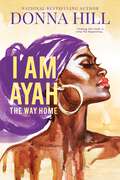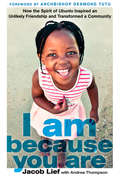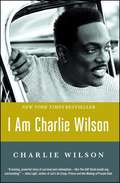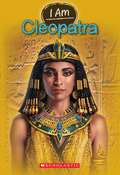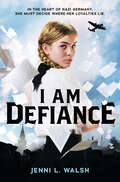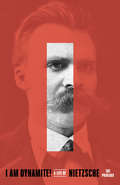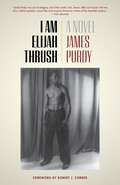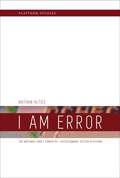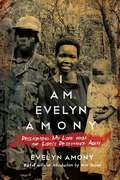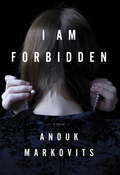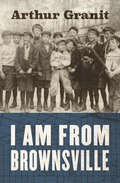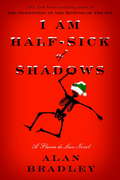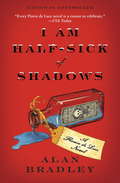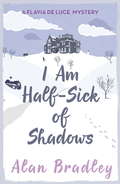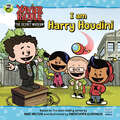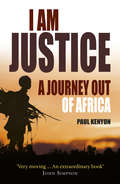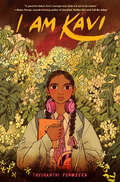- Table View
- List View
I AM MALALA - The Girl Who Stood Up for Education and was Shot by the Taliban
by Malala Yousafzai Christina LambI AM MALALA is the remarkable tale of a family uprooted by global terrorism, of the fight for girls' education, of a father who, himself a school owner, championed and encouraged his daughter to write and attend school, and of brave parents who have a fierce love for their daughter in a society that prizes sons.
I Adored a Lord: The Prince Catchers (The Prince Catchers #2)
by Katharine AsheThree very different sisters beguile society with their beauty and charm, but only one of them must fulfill a prophecy: marry a prince. Who is the mystery Prince Charming, and which sister will be his bride?All that clever, passionate Ravenna Caulfield wants is to stay far away from high society's mean girls.All that handsome, heroic Lord Vitor Courtenay wants is to dash from dangerous adventure to adventure.Now, snowbound in a castle with a bevy of the ton's scheming maidens all competing for a prince's hand in marriage, Ravenna's worst nightmare has come true.Now, playing babysitter to his spoiled prince of a half-brother and potential brides, Vitor is champing at the bit to be gone.When a stolen kiss in a stable leads to a corpse in a suit of armor, a canine kidnapping, and any number of scandalous liaisons, Ravenna and Vitor find themselves wrapped in a mystery they're perfectly paired to solve. But as for the mysteries of love and sex, Vitor's not about to let Ravenna escape until he's gotten what he desires . . .
I Always Loved You
by Robin OliveiraA novel of Mary Cassatt and Edgar Degas's great romance from the "New York Times "bestselling author of "My Name Is Mary Sutter" The young Mary Cassatt never thought moving to Paris after the Civil War to be an artist was going to be easy, but when, after a decade of work, her submission to the Paris Salon is rejected, Mary's fierce determination wavers. Her father is begging her to return to Philadelphia to find a husband before it is too late, her sister Lydia is falling mysteriously ill, and worse, Mary is beginning to doubt herself. Then one evening a friend introduces her to Edgar Degas and her life changes forever. Years later she will learn that he had begged for the introduction, but in that moment their meeting seems a miracle. So begins the defining period of her life and the most tempestuous of relationships. In "I Always Loved You," Robin Oliveira brilliantly re-creates the irresistible world of Belle Epoque Paris, writing with grace and uncommon insight into the passion and foibles of the human heart.
I Always Loved You
by Robin OliveiraA story of Mary Cassatt and Edgar Degas, from the New York Times bestselling author of My Name Is Mary SutterThe young Mary Cassatt never thought moving to Paris after the Civil War to be an artist was going to be easy, but when, after a decade of work, her submission to the Paris Salon is rejected, Mary's fierce determination wavers. Her father is begging her to return to Philadelphia to find a husband before it is too late, her sister Lydia is falling mysteriously ill, and worse, Mary is beginning to doubt herself. Then one evening a friend introduces her to Edgar Degas and her life changes forever. Years later she will learn that he had begged for the introduction, but in that moment their meeting seems a miracle. So begins the defining period of her life and the most tempestuous of relationships.In I Always Loved You, Robin Oliveira brilliantly re-creates the irresistible world of Belle Époque Paris, writing with grace and uncommon insight into the passion and foibles of the human heart.For readers of The Painted Girls by Cathy Marie Buchanan.
I Always Wanted to Fly: America’s Cold War Airmen
by Colonel Wolfgang W. SamuelUntil now, no book has covered all of Cold War air combat in the words of the men who waged it. In I Always Wanted to Fly, retired United States Air Force Colonel Wolfgang W. E. Samuel has gathered first-person memories from heroes of the cockpits and airstrips. Battling in dogfights when jets were novelties, saving lives in grueling airlifts, or flying dangerous reconnaissance missions deep into Soviet and Chinese airspace, these flyers waged America's longest and most secretively conducted air war. Many of the pilots Samuel interviewed invoke the same sentiment when asked why they risked their lives in the air—“I always wanted to fly.” While young, they were inspired by barnstormers, by World War I fighter legends, by the legendary Charles Lindbergh, and often just by seeing airplanes flying overhead. With the advent of World War II, many of these dreamers found themselves in cockpits soon after high school. Of those who survived World War II, many chose to continue following their dream, flying the Berlin Airlift, stopping the North Korean army during the “forgotten war” in Korea, and fighting in the Vietnam War. Told in personal narratives and reminiscences, I Always Wanted to Fly renders views from pilots' seats and flight decks during every air combat flashpoint from 1945–1968. Drawn from long exposure to the immense stress of warfare, the stories these warriors share are both heroic and historic. The author, a veteran of many secret reconnaissance missions, evokes individuals and scenes with authority and grace. He provides clear, concise historical context for each airman's memories. In I Always Wanted to Fly he has produced both a thrilling and inspirational acknowledgment of personal heroism and a valuable addition to our documentation of the Cold War.
I Am Abigail Adams (Xavier Riddle and the Secret Museum)
by Gabriella DeGennaroAn 8x8 book based on an episode from the PBS KIDS animated television series Xavier Riddle and the Secret Museum starring Abigail Adams.Based on the children's book series Ordinary People Change the World by New York Times bestselling author Brad Meltzer and illustrator Christopher Eliopoulos, the series will introduce kids to inspiring historical figures and the character virtues that helped them succeed.When Yadina, Brad, and Xavier need help solving a problem, they head to the Secret Museum for help! They're sent back in time to 1754 to meet one of the United States' Founding Mothers: Abigail Adams. This episode-based 8x8 will focus on the traits that made our heroes great--the traits that kids can aspire to in order to live heroically themselves.
I Am Algonquin: An Algonquin Quest Novel
by Rick RevelleAn exciting journey seen through the eyes of the Algonquin people. This book paints a vivid picture of the original peoples of North America before the arrival of Europeans. The novel follows the story of Mahingan and his family as they live the traditional Algonquin way of life in what is now Ontario in the early fourteenth century. Along the way we learn about the search for moose and the dramatic rare woodland buffalo hunt, conflicts with other Native nations, and the dangers of wolves and wolverines. We also witness the violent game of lacrosse, the terror of a forest fire, and the rituals that allow Algonquin boys to be declared full-grown men. But warfare is also part of their lives, and signs point to a defining conflict between Mahingan’s nation, its allies the Omàmiwinini (Algonquin), Ouendat (Huron), and the Nippissing against the Haudenosaunee (Iroquois). The battle’s aftermath may open the door to future journeys by Mahingan and his followers.
I Am Alive! A United States Marine's Story of Survival in a World War II Japanese POW Camp
by Charles Jackson Bruce H. NortonIn the bleak and bitter cold of a copper mine in northern Japan, a Chief Petty Officer of the U. S. Navy was given an opportunity to write a prisoner-of-war card for his wife. He was allowed ten words--he used three: "I AM ALIVE!" This message, classic in its poignancy of suffering and despair captures only too well what it meant to be a prisoner of the Japanese Army. Now, acclaimed military historian Major Bruce Norton USMC (Ret.) brings to light a long-forgotten memoir by a marine captured at Corregidor in the spring of 1942 and interned for three devastating years by the Japanese. With unflinching prose, the words of Marine Sergeant Major Charles Jackson describe the fierce yet impossible battle for Corregidor, the surrender of thousands of his comrades, the long forced marches, and the lethal reality of the P.O.W. camps. Joining some of the most important eyewitness accounts of war, I AM ALIVE! is a testament to the men who fought and died for their country. Jackson's unembellished account of what his fellow soldiers endured in the face of inhumanity pays tribute to the men who served America during the war--and shows why we would ultimately prevail.
I Am Ayah: The Way Home
by Donna Hill"[A] rich and tender story of family, home and love." —Ms. MagazineSet amid Sag Harbor’s vibrant African American history, bestselling author Donna Hill weaves a stunningly rich story about finding the way home…no matter how long the journey takes. Alessandra Fleming has spent most of her life running from her past. Her budding photography career, her life in Manhattan, all serve to distract from the secrets and guilt she’s never been able to face. Then the call. Her estranged father is in the hospital…and Alessandra must return home to Sag Harbor, crumbling the first wall between her past and her present.For some, coming home is a relief. For Alessandra, it’s a reminder of the family she’s lost, of the time she’ll never regain. But the answers—the secrets—of her family are hidden in the house, waiting for her. And the only one who may be able to help her uncover them is her father’s neighbor, Zach, who brings with him an attraction that’s intense and instantaneous, yet oddly familiar.Now Alessandra is being pulled back not only into her own complex family history, but into the richly documented lives of four extraordinary women. Generations touched by tragedy and triumph, despair and hope. And it’s in these aching echoes of the past that Alessandra’s own story—her mistakes and her capacity to love—will take shape, guiding her to the life she’s meant to live…and the extraordinary person she will become.
I Am Because You Are: How the Spirit of Ubuntu Inspired an Unlikely Friendship and Transformed a Commu nity
by Andrea Thompson Jacob LiefIn 1998, Jacob Lief, a 21-year-old American university student, met school teacher Malizole "Banks" Gwaxula in a township tavern in Port Elizabeth, South Africa. After bonding over beers and a shared passion for education, Gwaxula invited Lief to live with him in the township. Inspired by their fortuitous meeting—which brought together two men separated by race, nationality, and age-and by the spirit of ubuntu, roughly translated as "I am because you are"—the two men embarked on an unexpectedly profound journey. Their vision? To provide vulnerable children in the townships with what every child deserves-everything. Today, their organization, Ubuntu Education Fund, is upending conventional wisdom about how to break the cycle of poverty. Shunning traditional development models, Ubuntu has redefined the concept of scale, focusing on how deeply it can impact each child's life rather than how many it can reach. Ubuntu provides everything a child needs and deserves, from prenatal care for pregnant mothers to support through university-essentially, from cradle to career. Their child-centered approach reminds us that one's birthplace should not determine one's future. I Am Because You Are sets forth an unflinching portrayal of the unique rewards and challenges of the nonprofit world while offering a bold vision for a new model of development.
I Am Charlie Wilson
by Charlie WilsonThe long-awaited New York Times bestselling memoir of seven-time Grammy-nominated artist Charlie Wilson, the iconic R&B and Funk singer-songwriter-producer and former lead singer of The Gap Band—interwoven with his recollections of collaborating with fellow artists such as Stevie Wonder, Kanye West, and Snoop Dogg.Recognized the world over for his distinct voice and timeless hits spanning a career of nearly half a century, Charlie Wilson is one of the most celebrated musicians of his generation. So it took friends and family by surprise when he checked into rehab and revealed that he had been not only homeless, but also helpless. Here is the riveting story of how love and faith carried him through not only his addiction, but also prostate cancer. Here, too, is the story of his work in the music business, including a career resurgence that saw collaborations with some of the most sought-after artists of today, including Pharrell and Justin Timberlake. Now over twenty years sober, Wilson recounts a life filled with vertiginous highs and heartbreaking lows. His is a story of triumph over adversity, courage in the face of extreme hardship, and love when all else is lost. It is a tale of the last sixty years in social and pop culture history, and one that will stay with you for years to come.
I Am Cleopatra
by Grace NorwichTo this day, Cleopatra remains a popular figure in Western culture, with books, plays, and movies devoted to her story. I AM CLEOPATRA will follow her journey from its illustrious beginning to its tragic end. Learn all about this legendary queen's fascinating life in Scholastic's I AM biography series.
I Am Defiance: A Novel Of Wwii
by Jenni L. WalshBrigitte tries not to ask questions. They don't seem very welcome at her League of German Girls meetings, where she and her friends learn about their duties to Hitler's war effort.But she can't help asking questions when a mysterious pamphlet appears in her mailbox: a pamphlet full of words like resistance and freedom, from a group that calls itself the White Rose. Brigitte's father and older sister, Angelika, seem to agree with the forbidden papers -- an opinion that is dangerous even to whisper at home. And when Angelika becomes involved with secret resistance efforts, Brigitte's questions only bloom.Could Angelika be connected to the White Rose? Is Brigitte's family in danger of being arrested? And if she chooses a side, will Brigitte be able to take a stand?
I Am Dynamite!: A Life of Nietzsche
by Sue PrideauxA groundbreaking new biography of philosophy’s greatest iconoclast Friedrich Nietzsche is one of the most enigmatic figures in philosophy, and his concepts—the Übermensch, the will to power, slave morality—have fundamentally reshaped our understanding of the human condition. But what do most people really know of Nietzsche—beyond the mustache, the scowl, and the lingering association with nihilism and fascism? Where do we place a thinker who was equally beloved by Albert Camus, Ayn Rand, Martin Buber, and Adolf Hitler? Nietzsche wrote that all philosophy is autobiographical, and in this vividly compelling, myth-shattering biography, Sue Prideaux brings readers into the world of this brilliant, eccentric, and deeply troubled man, illuminating the events and people that shaped his life and work. From his placid, devoutly Christian upbringing—overshadowed by the mysterious death of his father—through his teaching career, lonely philosophizing on high mountains, and heart-breaking descent into madness, Prideaux documents Nietzsche’s intellectual and emotional life with a novelist’s insight and sensitivity. She also produces unforgettable portraits of the people who were most important to him, including Richard and Cosima Wagner, Lou Salomé, the femme fatale who broke his heart; and his sister Elizabeth, a rabid German nationalist and anti-Semite who manipulated his texts and turned the Nietzsche archive into a destination for Nazi ideologues. I Am Dynamite! is the essential biography for anyone seeking to understand history's most misunderstood philosopher.
I Am Elijah Thrush
by James PurdyOn its surface, I Am Elijah Thrush is the story of Millicent De Frayne and her sensational half-century campaign to win the love of Elijah Thrush. Elijah, after ruining the lives of countless men and women, is finally in love “incorrectly, if not indecently,” with his great-grandson, Bird of Heaven. To support an unusual habit, a young Black man, Albert Peggs, reluctantly agrees to tell their remarkable story. It is in this telling that the ambitions, desires, and true natures of Elijah, Millicent, and Albert come to light. With a delicately controlled balance of whimsy and pathos, James Purdy gives us this comedy of the heroic, the tragic, and the truly bizarre.Met with critical bewilderment upon its initial publication fifty years ago, this new edition offers a Foreword by Robert J. Corber illuminating Purdy’s “complicated allegory” of objectification, desire, and race in the immediate post–civil rights moment.
I Am Error: The Nintendo Family Computer / Entertainment System Platform
by Nathan AlticeIn the 1987 Nintendo Entertainment System videogame Zelda II: The Adventure of Link, a character famously declared: I AM ERROR. Puzzled players assumed that this cryptic mesage was a programming flaw, but it was actually a clumsy Japanese-English translation of "My Name is Error," a benign programmer's joke. In I AM ERROR Nathan Altice explores the complex material histories of the Nintendo Entertainment System (and its Japanese predecessor, the Family Computer), offering a detailed analysis of its programming and engineering, its expressive affordances, and its cultural significance. Nintendo games were rife with mistranslated texts, but, as Altice explains, Nintendo's translation challenges were not just linguistic but also material, with consequences beyond simple misinterpretation. Emphasizing the technical and material evolution of Nintendo's first cartridge-based platform, Altice describes the development of the Family Computer (or Famicom) and its computational architecture; the "translation" problems faced while adapting the Famicom for the U. S. videogame market as the redesigned Entertainment System; Nintendo's breakthrough console title Super Mario Bros. and its remarkable software innovations; the introduction of Nintendo's short-lived proprietary disk format and the design repercussions on The Legend of Zelda; Nintendo's efforts to extend their console's lifespan through cartridge augmentations; the Famicom's Audio Processing Unit (APU) and its importance for the chiptunes genre; and the emergence of software emulators and the new kinds of play they enabled.
I Am Evelyn Amony: Reclaiming My Life from the Lord's Resistance Army
by Evelyn AmonyI Am Evelyn Amony tells a harrowing story of heartbreaking loss, unrelenting horror, and courageous survival. Abducted in 1994 at the age of eleven, Amony spent eleven years inside the Lord's Resistance Army, becoming a forced wife to Joseph Kony and mother to his children. She takes the reader into the inner circles of LRA commanders and reveals unprecedented personal and domestic details about Joseph Kony. Her account unflinchingly conveys the moral difficulties of choosing survival in a situation fraught with violence, threat, and death. Amony was freed in 2004 following her capture by the Ugandan military. Despite the trauma she endured with the LRA, Amony joined a Ugandan peace delegation to the LRA in 2006, trying to convince Kony to end the war that had lasted more than two decades. She recounts those experiences, as well as the stigma she and her children faced when she returned home as an adult. This extraordinary testimony shatters stereotypes of war-affected women, revealing the complex ways that Amony navigated life inside the LRA and her current work as a human rights advocate to make a better life for her children and other women affected by war.
I Am Forbidden
by Anouk MarkovitsA family is torn apart by fierce belief and private longing in this unprecedented journey deep inside the most insular Hasidic sect, the Satmar. Sweeping from the Central European countryside just before World War II to Paris to contemporary Williamsburg, Brooklyn, I Am Forbidden brings to life four generations of one Satmar family. Opening in 1939 Transylvania, five-year-old Josef witnesses the murder of his family by the Romanian Iron Guard and is rescued by a Gentile maid to be raised as her own son. Five years later, Josef rescues a young girl, Mila, after her parents are killed while running to meet the Rebbe they hoped would save them. Josef helps Mila reach Zalman Stern, a leader in the Satmar community, in whose home Mila is raised as a sister to Zalman's daughter, Atara. As the two girls mature, Mila's faith intensifies, while her beloved sister Atara discovers a world of books and learning that she cannot ignore. With the rise of communism in central Europe, the family moves to Paris, to the Marais, where Zalman tries to raise his children apart from the city in which they live. When the two girls come of age, Mila marries within the faith, while Atara continues to question fundamentalist doctrine. The different choices the two sisters makes force them apart until a dangerous secret threatens to banish them from the only community they've ever known. A beautifully crafted, emotionally gripping story of what happens when unwavering love, unyielding law, and centuries of tradition collide, I Am Forbidden announces the arrival of an extraordinarily gifted new voice and opens a startling window on a world long closed to most of us, until now.
I Am From Brownsville
by Arthur GranitThe classic story collection brings to life a close-knit Jewish neighborhood of Brooklyn as a group of boys make their journey to adulthood. In these thirteen stories Arthur Granit introduces readers to the lost world of Brownsville as it was in the 1920s. As neighborhood boys grow up together through adventures and misadventures, friendships and trials, Granit observes their evolution against the backdrop of a changing city. Here is the wild humor—and occasional sadness—of life in a teeming Brooklyn Jewish community.
I Am Half-Sick of Shadows (Flavia De Luce Mysteries Ser. #4)
by Alan BradleyWhat better Christmas surprise for detective-in-training Flavia de Luce than a dreadful murder under Buckshaw's roof - and a snowbound house full of suspects!It's Christmas time, and our beloved Flavia is tucked away in her laboratory whipping up a sticky concoction to trap that infamous sneak, Saint Nick, and thereby prove once and for all - despite the claims of her evil sisters - that he does exist. But she is soon distracted from her task: Colonel de Luce, in desperate need of funds, has rented the family's crumbling manor house to a film company for the holidays. When its crew arrives from London to shoot a movie starring the reclusive and renowned actress, Phyllis Wyvern, there's no end to the disruptions - and dramas - demanding Flavia's attention.When Wyvern is convinced to perform a famous scene to help raise funds for the local church, it is decided that Buckshaw Manor is the only suitable location. Its foyer alone is bigger than the parish hall, and could fit every man, woman, and child in Bishop's Lacey, to a soul. It's almost Christmas Eve, but - to no one's surprise - all of the village inhabitants fight their way through a raging snowstorm to be in the audience that magical night. As the actors take to the stage, however, the blizzard sets in, and it becomes clear that the villagers will have to hunker down at Buckshaw for the night. Sleeping head to toe in the de Luces' foyer seems amenable to most, until word spreads of the evening's shocking conclusion - Phyllis Wyvern is found strangled to death in the Blue Bedroom, with a length of film from one of her movies tied in an elaborate bow around her neck. But who among the assembled guests would stage such a chilling scene? As the storm worsens and the list of suspects grows, Flavia must use every ounce of her chemical cleverness and crime-solving prowess to ferret out a killer hidden in plain sight. But when she does piece the puzzle together and deduce who has committed this twisted crime, will Flavia be able to escape in one piece?
I Am Half-Sick of Shadows: A Flavia de Luce Novel ( A Flavia de Luce Novel #4)
by Alan Bradley<P>It's Christmastime, and Flavia de Luce--an eleven-year-old sleuth with a passion for chemistry--is tucked away in her laboratory, whipping up a concoction to ensnare Saint Nick. But she is soon distracted when a film crew arrives at Buckshaw, the de Luces' decaying English estate, to shoot a movie starring the famed Phyllis Wyvern. <P>Amid a raging blizzard, the entire village of Bishop's Lacey gathers at Buckshaw to watch Wyvern perform, yet nobody is prepared for the evening's shocking conclusion: a body found strangled to death with a length of film. <P>But who among the assembled guests would stage such a chilling scene? As the storm worsens and the list of suspects grows, Flavia must ferret out a killer hidden in plain sight.
I Am Half-Sick of Shadows: The gripping fourth novel in the cosy Flavia De Luce series (Flavia de Luce Mystery)
by Alan BradleyIn the deep midwinter, there's a murder to solve... Christmas is coming and the snow is falling, but with the de Luce family finances in a parlous state, Colonel de Luce has been forced to rent out the family home to a film company.For Flavia and her sisters it's as if all their belated Christmases have come at once - but filming is soon slowed by a series of nasty accidents and then brought to a halt as a heavy snowstorm cuts Buckshaw off from the outside world. As they prepare to wait out the weather, they are stunned by a gruesomely dramatic murder - and suddenly Flavia, in the midst of designing an experiment to prove the existence of Father Christmas - has another, far deadlier mystery to solve.Praise for the historical Flavia de Luce mysteries: 'The Flavia de Luce novels are now a cult favourite' Mail on Sunday 'A cross between Dodie Smith's I Capture The Castle and the Addams family...delightfully entertaining' Guardian Fans of M. C. Beaton's Agatha Raisin, Frances Brody and Alexander McCall Smith will enjoy the Flavia de Luce mysteries: 1. Sweetness at the Bottom of the Pie 2. The Weed That Strings the Hangman's Bag 3. A Red Herring Without Mustard 4. I Am Half Sick of Shadows 5. Speaking From Among the Bones 6. The Dead in Their Vaulted Arches 7. As Chimney Sweepers Come To Dust 8. Thrice the Brinded Cat Hath Mew'd 9. The Grave's a Fine and Private Place If you're looking for a cosy crime series to keep you hooked then look no further than the Flavia de Luce mysteries. * Each Flavia de Luce mystery can be read as a standalone or in series order *
I Am Harry Houdini (Xavier Riddle and the Secret Museum)
by Brooke VitaleAn 8x8 based on an episode from the PBS KIDS animated television series Xavier Riddle and the Secret Museum starring Harry Houdini.Based on the children's book series Ordinary People Change the World by New York Times bestselling author Brad Meltzer and illustrator Christopher Eliopoulos, the series will introduce kids to inspiring historical figures and the character virtues that helped them succeed. Brad is too scared to spend a full night in the museum's nature exhibit so the Secret Museum sends him and his friends to meet Harry Houdini! This episode-based 8x8 will focus on the traits that made our heroes great--the traits that kids can aspire to in order to live heroically themselves.
I Am Justice: A Journey Out of Africa
by Paul KenyonEighty miles off the Libyan coast water is leaking rapidly into the bottom of a dilapidated wooden boat. Twenty-seven men, crammed in side-by-side, desperately attempt to bail it out, but the boat is sinking. In the distance one of their number spots a ship and, forcing the last moments of life from the engine, they move towards it. But the crew refuses to allow them on board. Instead the men scramble onto the floats of a huge industrial tuna net, and watch as their boat rolls over and disappears into the heaving Mediterranean.Like tens of thousands of others Justice set off from his rural village with an idealised vision of an new life in England - the 'home' country - desperate just to earn his way and help his orphaned brother and sister left behind. During his long journey to the African coast, he's captured, jailed and tortured, before escaping and heading northwards again. Once in Tripoli he's duped into handing over his life savings for a trip in a wreck of a boat across miles of open sea to almost certain death. But there is also compassion here and he meets old and wise souls along the way. The tuna net is not the end of Justice's story. It is an extraordinary tale of courage, and an important account of a life caught between cultures, on the edge of survival.
I Am Kavi
by Thushanthi PonweeraCaught between two worlds—a poverty-stricken village and a fancy big-city school—a young Sri Lankan girl must decide who she really is and where she really belongs.1998, Colombo. The Sri Lankan Civil War is raging, but everyday life must go on. At Kavi&’s school, her friends talk about the weekly Top 40, the Backstreet Boys, Shahrukh Khan, Leo & Kate… and who died—or didn&’t—in the latest bombing. But Kavi is afraid of something even scarier than war. She fears that if her friends discover her secret—that she is not who she is pretending to be—they&’ll stop talking to her.I want to be friends with these / happy, / fearless, / girls / who look like they / belong.So I could also be / happy, / fearless, / and maybe even / belong.Kavi&’s scholarship to her elite new school was supposed to be everything she ever wanted, but as she tries to find some semblance of normalcy in a country on fire, nothing is going according to plan. In an effort to fit in with her wealthy, glittering, and self-assured new classmates, Kavi begins telling lies, trading her old life—where she&’s a poor girl whose mother has chosen a new husband over her daughter—for a new one, where she&’s rich, loved, and wanted. But how long can you pretend to be someone else?This dazzling novel-in-verse comes from an astonishing new talent who lived through the civil war herself. Perfect for fans of Jamine Warga, Supriya Kelkar, and Rajani LaRocca, I Am Kavi centers a powerful South Asian voice, and stars an unforgettable heroine each and every one of us can relate to. "KAVI'S COURAGE AND VOICE ARE NOT TO BE MISSED."—Reem Faruqi, award-winning author of Call Me Adnan, Unsettled, and Golden Girl"I LOVED IT!"—Nizrana Farook, award-winning author of The Girl Who Stole an Elephant"POWERFULLY WRITTEN."—Lyn Miller-Lachmann, author of Los Angeles Times Book Prize Winner Torch"LUSH AND EVOCATIVE... A STUNNING DEBUT."—Kate Albus, award-winning author of A Place to Hang the MoonA Junior Library Guild Gold Standard SelectionAn Indies Introduce Selection

